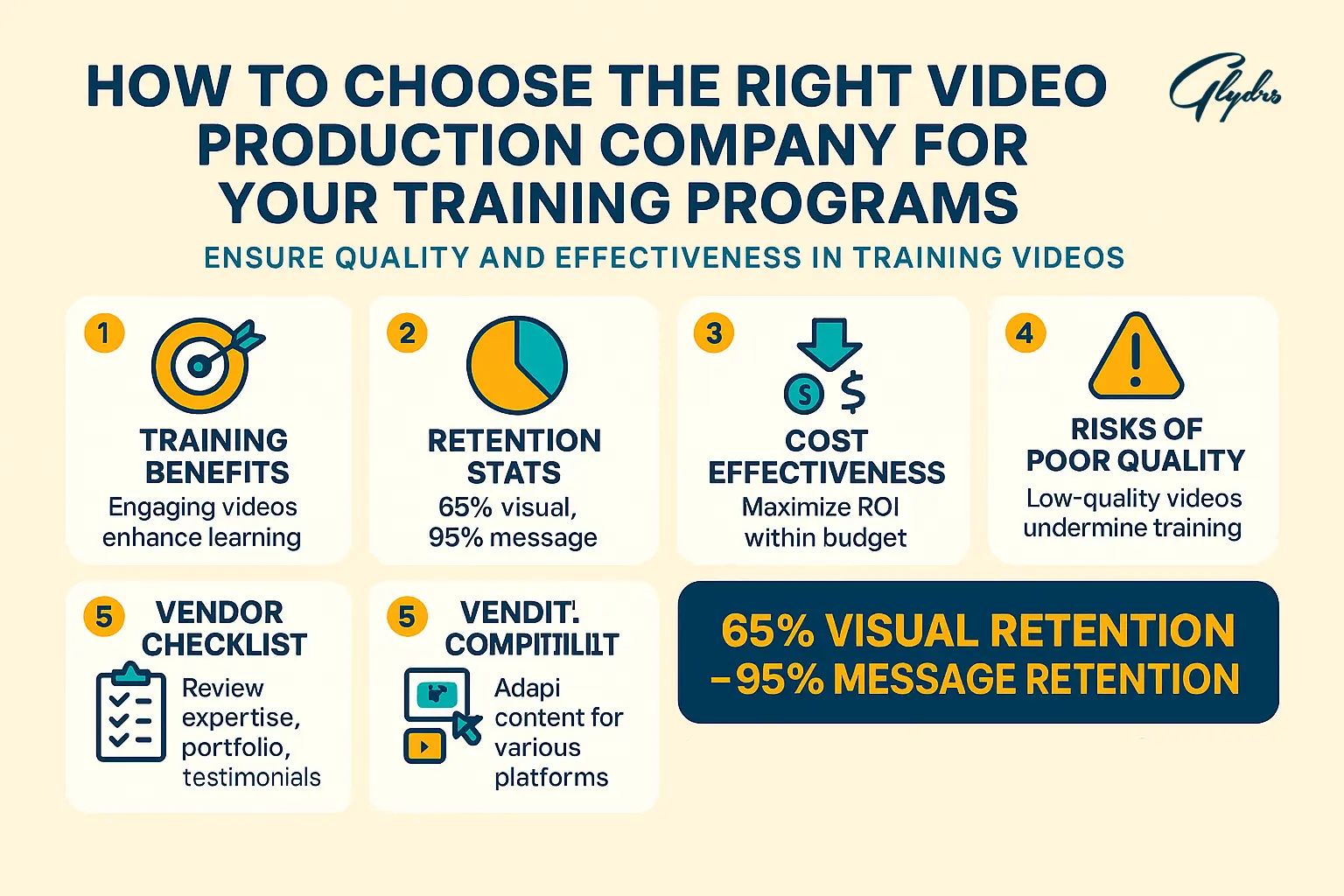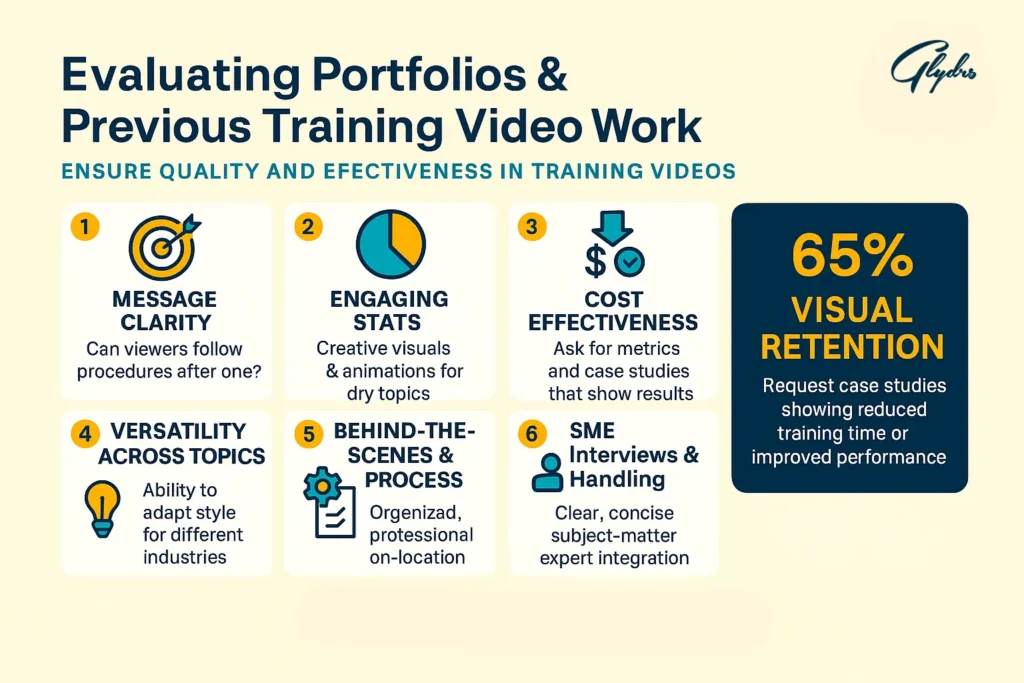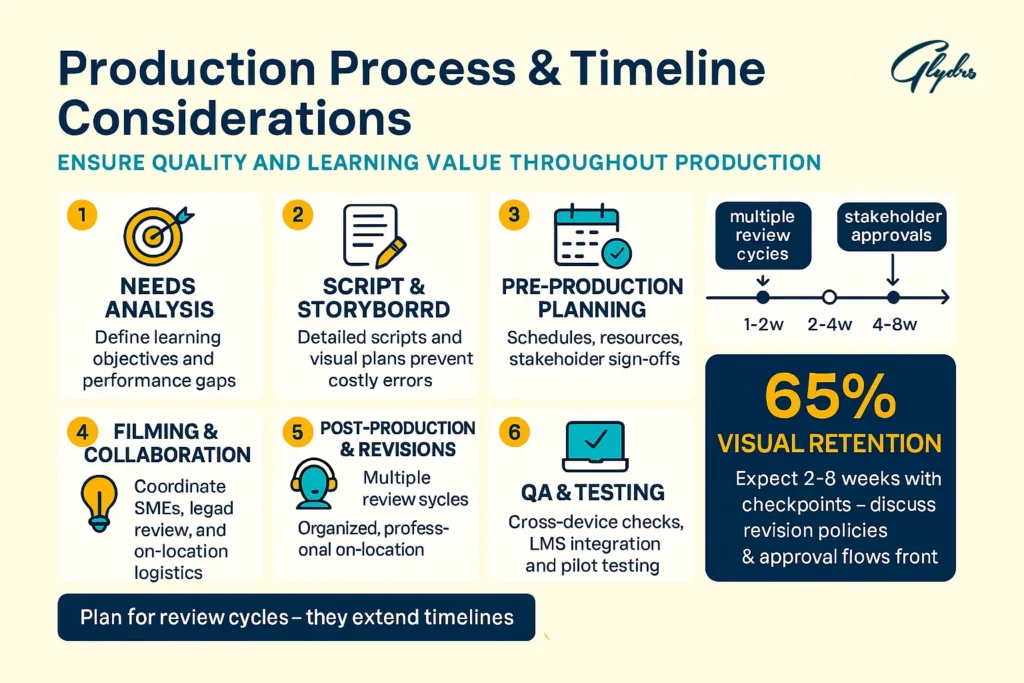
27 Aug How to Choose the Right Video Production Company for Your Training Programs
Video Production for training programs: How to choose it?
You’re witnessing a fundamental shift in how organizations approach employee development. Traditional classroom-style training is giving way to video-based learning, and for good reason. Research consistently shows that visual learning increases retention rates by up to 65%, compared to just 10% for text-based materials. When you invest in video production for training programs, you’re not just following a trend—you’re making a strategic decision that impacts your bottom line.
The numbers speak volumes about the effectiveness of training videos. Employees retain 95% of a message when they watch it in a video, compared to only 10% when reading text. This dramatic difference means your training investment reaches and influences your workforce. Beyond retention, video training reduces the time needed for employees to grasp new concepts by 40% on average, translating to faster onboarding, quicker skill development, and reduced training costs over time.
High-quality training videos serve as evergreen assets that can train hundreds or thousands of employees without additional instructor costs, making them one of the most cost-effective training investments you can make.
However, poor-quality training videos create the opposite effect. Grainy footage, unclear audio, or confusing content not only fails to educate but can damage your organization’s credibility. When employees struggle to understand training materials due to production issues, you’re not just wasting money—you’re potentially creating compliance risks and knowledge gaps that could impact your business operations.
The shift to remote and hybrid work environments has made professional training videos even more critical. Your employees need engaging, accessible content that works across different devices and platforms. This is where choosing the right video production partner becomes essential for your organization’s learning and development success.
Understanding Your Training Video Objectives and Requirements
Before you start researching production companies, you need crystal-clear objectives for your training content. Your goals will determine everything from the production style to the budget requirements. Are you creating onboarding videos for new hires, compliance training to meet regulatory requirements, or skill development content to enhance performance?
Each type of training video serves different purposes and requires different approaches. Onboarding videos might focus on company culture and basic procedures, requiring a warm, welcoming tone with clear visual guidance. Compliance training often demands precise information delivery with documentation capabilities, while technical skills training might require detailed close-ups, step-by-step demonstrations, and interactive elements.
Your target audience significantly influences production decisions. Are you training front-line employees who might access content on mobile devices, or are you developing executive-level content for boardroom presentations? Understanding learning preferences within your organization helps shape content strategy. Some learners prefer visual demonstrations, others benefit from interactive elements, and many require closed captions or multilingual options for accessibility compliance.
| Training Type | Primary Focus | Production Considerations |
|---|---|---|
| Onboarding | Culture & Procedures | Engaging visuals, company branding |
| Compliance | Regulatory Requirements | Clear documentation, testing integration |
| Technical Skills | Hands-on Learning | Detailed demonstrations, close-up shots |
| Leadership Development | Soft Skills | Scenario-based content, role-playing |
Planning for scalability from the beginning saves significant costs and ensures consistency. If you’re creating one training module now but plan to develop a comprehensive library, you need a production partner who can maintain visual consistency, understand your evolving needs, and potentially offer volume discounts for ongoing work.
Essential Expertise to Look for in Training Video Production Companies
Not all video production companies understand the unique requirements of educational content. You need partners who grasp adult learning principles, not just videography techniques. The most visually stunning video falls flat if it doesn’t facilitate actual learning and behavioral change.
Look for production companies that demonstrate an understanding of instructional design principles. They should ask about learning objectives, assessment methods, and how the video fits into your broader training ecosystem. Companies experienced in video production for training programs will inquire about your existing learning management system, discuss interactive elements, and suggest ways to measure training effectiveness.
Experience with corporate training environments is invaluable. Training videos often need to address sensitive topics, complex procedures, or regulatory requirements. A production company familiar with corporate settings understands the importance of accuracy, compliance considerations, and the need for content that works within existing organizational structures.
The ability to translate complex information into digestible visual content separates good training video producers from great ones. They should demonstrate skills in breaking down complicated processes, using graphics and animations to clarify concepts, and maintaining viewer engagement throughout longer training sessions. This expertise becomes particularly crucial when dealing with technical subjects or abstract concepts that challenge traditional training methods.
Interactive and engaging training formats represent the cutting edge of educational video production. Your chosen partner should offer capabilities beyond basic video production, including interactive elements, branching scenarios, knowledge checks, and integration with learning management systems. These features transform passive viewing into active learning experiences.

Evaluating Portfolios and Previous Training Video Work
When reviewing portfolios, you’re looking for more than technical proficiency. Focus on how effectively the videos communicate their intended messages. Can you follow complex procedures after watching them once? Do the videos maintain your attention throughout? Are instructions clear and actionable?
Pay particular attention to how production companies handle dry or technical content. Training videos often cover topics that aren’t inherently exciting, so you need partners who can make compliance training engaging or technical procedures memorable. Look for creative approaches to potentially boring subjects, effective use of graphics and animations, and a clear information hierarchy that guides viewers through content logically.
Client success stories and measurable outcomes provide crucial insights into a production company’s effectiveness. Rather than just showcasing pretty visuals, the best training video producers can demonstrate how their content improved learning outcomes, reduced training time, or enhanced employee performance. Ask for specific metrics and case studies that show real business impact.
Analyze the versatility demonstrated across different training topics and industries. While industry-specific experience is valuable, a production company that has successfully created diverse training content often brings fresh perspectives and creative solutions to your projects. They understand that different subjects require different approaches and can adapt their style accordingly.
Review both the final products and any available behind-the-scenes content to understand the production company’s process. How do they handle subject matter expert interviews? Do they seem organized and professional on location? Can they work effectively in corporate environments without disrupting business operations?
Technical Requirements and Production Capabilities for Training Content
Training videos demand specific technical standards that differ from marketing or entertainment content. Audio clarity becomes paramount when employees need to understand detailed instructions or safety procedures. Poor audio quality doesn’t just reduce engagement—it can create actual safety risks or compliance issues if critical information gets lost.
Visual clarity requirements for training content often exceed those of other video types. When you’re showing detailed procedures, close-up work, or safety demonstrations, every visual element must be sharp and clear. Your production partner should have equipment capable of capturing fine details, adequate lighting for various environments, and post-production skills to enhance clarity without sacrificing authenticity.
Graphics, animations, and text overlays serve functional purposes in training videos beyond aesthetic appeal. They reinforce key points, provide step-by-step guidance, and accommodate different learning styles. Your chosen production company should demonstrate proficiency in creating clear, professional graphics that enhance learning rather than distract from core content.
Interactive elements and multimedia integration capabilities are becoming standard expectations for modern training content. Whether it’s clickable hotspots, branching scenarios, or knowledge checks, your production partner should understand how these elements integrate with learning management systems and contribute to measurable learning outcomes.
Platform compatibility and delivery format considerations affect how employees access your training content. Your production company should understand the technical requirements of your learning management system, mobile accessibility needs, and any bandwidth constraints that might affect video delivery in your organization.
Budget Planning and Return on Investment for Training Videos
Understanding typical pricing structures for video production for training programs helps you set realistic budget expectations and evaluate proposals effectively. Training video costs vary significantly based on complexity, length, production value, and post-production requirements. Simple talking-head style videos cost less than complex demonstrations requiring multiple locations and specialized equipment.
Several factors influence training video production costs beyond basic filming. Script development and instructional design consultation add value but increase initial investment. Subject matter expert time, location fees, specialized equipment for detailed demonstrations, and extensive post-production work all impact final costs. Understanding these variables helps you make informed decisions about where to invest your budget for maximum impact.
Calculating return on investment for training videos involves both direct and indirect benefits. Direct savings come from reduced instructor time, eliminated travel costs for centralized training, and decreased training materials printing. Indirect benefits include improved knowledge retention, faster employee onboarding, consistent training delivery, and reduced compliance risks.
Quality training videos often pay for themselves within the first year through reduced training delivery costs alone, while continuing to provide value for years with minimal additional investment.
Hidden costs can surprise unprepared buyers. Additional rounds of revisions, extended post-production timelines, music licensing, closed captioning, translation services, and hosting platform fees might not appear in initial quotes. Discuss these potential expenses upfront to avoid budget surprises and ensure your chosen production company provides transparent pricing.
Long-term training video library development requires strategic budget planning. Volume discounts, template development for consistent branding, and established workflows can reduce per-video costs as your library grows. Consider the total cost of ownership, including potential updates and refresher content creation, when evaluating production partners and budget allocations.

Production Process and Timeline Considerations
A well-defined production workflow distinguishes professional training video companies from general videographers. The process typically begins with needs analysis and learning objective definition, followed by script development, storyboard creation, pre-production planning, filming, and post-production editing. Each phase serves specific purposes in creating effective educational content.
Pre-production planning becomes particularly crucial for training videos because accuracy and completeness directly impact learning outcomes. Your production partner should invest significant time in understanding your subject matter, consulting with internal experts, and creating detailed scripts and storyboards. This upfront investment prevents costly mistakes and ensures the final product meets your educational objectives.
Collaboration requirements during filming often exceed those of other video types. Subject matter experts need to review content for accuracy, legal teams might need to approve compliance-related information, and multiple stakeholders often provide input on messaging and tone. Your production company should facilitate this collaboration smoothly without derailing timelines.
Post-production timelines for training videos can extend longer than expected due to the iterative nature of educational content creation. Multiple review cycles ensure accuracy and effectiveness, but they also add time to the overall production schedule. Discuss revision policies, approval processes, and timeline expectations upfront to avoid frustration and delays.
Quality assurance and testing phases are essential for training content, but often overlooked in initial timeline planning. Testing video functionality across different devices, verifying learning management system integration, and conducting pilot testing with actual employees all require time but contribute significantly to final product success.
Critical Questions to Ask Potential Training Video Partners
Your conversations with potential production partners should reveal their understanding of educational content creation beyond technical video skills. Ask about their experience with similar training programs and learning objectives. Companies experienced in video production for training programs will demonstrate familiarity with instructional design principles and adult learning theory.
Understanding their approach to making complex or technical content accessible reveals crucial capabilities. Can they explain their strategies for breaking down complicated procedures? Do they have examples of transforming dry compliance topics into engaging content? Their answers will indicate whether they truly understand the unique challenges of educational video production.
Process for incorporating subject matter expert input and feedback shows how well the production company collaborates with your internal team. Training videos require significant input from people who understand your business processes, safety procedures, or technical systems. Your production partner should have established workflows for managing this collaboration efficiently.
Revision policies and included edit rounds directly impact both budget and timeline. Training content often requires more revisions than other video types due to accuracy requirements and multiple stakeholder input. Understand what’s included in the base price and what constitutes additional charges to avoid budget surprises.
Ownership rights and usage permissions for training content affect your long-term flexibility and costs. Can you modify content internally? Are you free to use footage across multiple platforms? Can you create derivative works or updated versions? These rights become particularly important as your training needs evolve.
Support for updates and refresher content creation addresses the ongoing nature of employee training. Procedures change, regulations update, and new employees need training. Your production partner should offer ongoing support options and maintain source files that enable efficient content updates.
Red Flags and Warning Signs to Avoid
Lack of educational or training video experience in their portfolio should give you pause. General video production skills don’t automatically translate to effective training content creation. Look for evidence that they understand the differences between entertainment, marketing, and educational video production.
Inability to demonstrate understanding of learning principles represents a fundamental gap in training video production. If potential partners can’t discuss adult learning theory, knowledge retention strategies, or measurable learning outcomes, they’re likely approaching training videos as generic content rather than specialized educational tools.
Poor communication or unresponsiveness during initial consultations often predicts collaboration problems throughout the production process. Training video creation requires extensive communication with subject matter experts, multiple review cycles, and coordination with various stakeholders. Communication issues early in the relationship typically worsen under project pressure.
Extremely low pricing that suggests corners will be cut should raise concerns about final quality and project completion. Training videos serve critical business functions, and subpar quality can create compliance risks, knowledge gaps, or credibility issues. While budget considerations are important, the cheapest option rarely delivers the best value.
No clear production process or timeline commitments indicate disorganization that can derail training initiatives. You need reliable partners who can commit to deadlines, especially when training programs are tied to regulatory requirements, new employee start dates, or business operational changes.
Reluctance to provide references from previous training clients suggests potential issues with past projects or client relationships. Reputable training video producers should gladly connect you with satisfied clients who can speak to their experience, professionalism, and results achieved.
Making the Final Decision and Establishing a Successful Partnership
Weighing all factors to select the best fit for your training goals requires balancing multiple considerations, including expertise, portfolio quality, budget, timeline, and cultural fit. Create a scoring matrix that weights factors according to your priorities, helping you make objective comparisons between potential partners.
Contract negotiation and establishing clear expectations prevent misunderstandings and disputes during production. Address revision policies, timeline commitments, quality standards, deliverable formats, and ownership rights explicitly. Include provisions for scope changes, additional fees, and project termination if necessary.
Communication protocols and project management systems should be established before production begins. Identify primary contacts, preferred communication methods, meeting schedules, and approval processes. Clear communication structures prevent delays and ensure all stakeholders stay informed throughout the production process.
Planning for long-term collaboration and ongoing training needs creates value beyond individual projects. Discuss volume discounts, template development, source file maintenance, and update processes. Building relationships with reliable production partners simplifies future training initiatives and ensures consistency across your content library.
Success metrics and evaluation criteria should be defined upfront to measure the effectiveness of your training videos and production partnership. Consider both quantitative measures like completion rates and assessment scores, and qualitative factors like employee feedback and knowledge retention. Regular evaluation helps optimize future productions and demonstrates return on investment. Building relationships that support your organization’s learning culture extends beyond individual video projects. The best production partners become extensions of your training team, understanding your organizational goals, employee needs, and evolving requirements. This partnership approach delivers better results and creates lasting value for your video production for training programs and initiatives.
Your Path to Training Video Success
Selecting the right video production company for your training program represents a strategic investment in your organization’s future. The partner you choose will influence not just the immediate project, but potentially your entire approach to employee development and knowledge sharing. Take the time necessary to find a production company that understands your unique requirements, shares your commitment to quality, and can grow with your evolving training needs.
Remember that the cheapest option rarely delivers the best value, while the most expensive doesn’t guarantee success. Focus on finding partners who demonstrate a genuine understanding of educational content creation, show enthusiasm for your training objectives, and can provide measurable results that justify your investment.
The right video production partner will transform your training challenges into competitive advantages, creating content that engages employees, improves performance, and delivers lasting business value. Your employees deserve training that respects their time and intelligence, and your organization deserves content that drives real results. Choose wisely, and your training videos will serve your organization effectively for years to come.
Keep reading and uncover secrets that can change the way you work. How to Do Corporate Training Video Production Right


No Comments